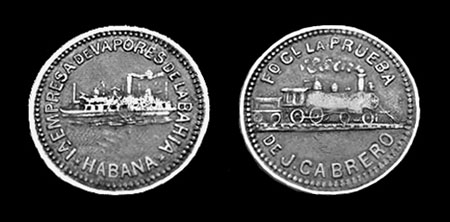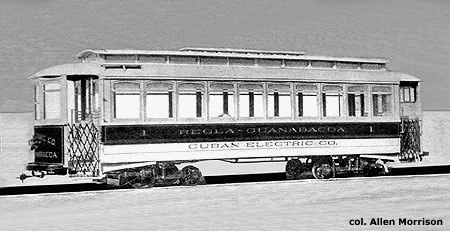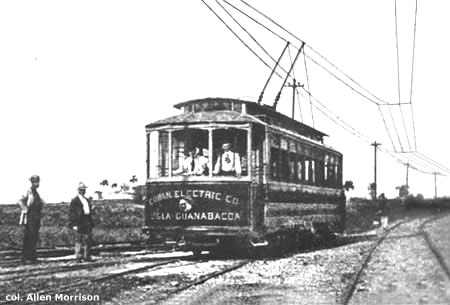GUANABACOA BY Allen Morrison This small city 4 km east of Havana Bay [see map] had Cuba's first animal-powered railway and also its first electric line. The story began in a coal mine.



Track gauge remained 1435 mm and CEC used FLP's Stephenson cars as trailers. In 1907 CEC sold its tramway to the Havana Central Railroad, which had just constructed interurban lines to Guanajay and Güines. HCR opened a new line along Av. Corral Falso to La Jata in 1909 and ordered ten new cars (similar to the first four) from Brill in 1910. Later that year it also electrified the 1858 steam line to Fesser, via Guanabacoa's south side [see map]. Havana Central Railroad was controlled by United Railways of Havana. The photograph below shows electric tram number 14 at the "F.C.U." (Ferrocarriles Unidos) station in Guanabacoa. Signs on both the front and side identify the route: "Regla - Guanabacoa" [col. AM]: |

Havana Central Railroad and Havana Electric Railway all planned a streetcar connection between Havana and Guanabacoa. HER never built one, but at some point between 1910 and 1930 HCR (a.k.a. United Railways of Havana) electrified the steam railroad tracks between Guanabacoa and Agua Dulce [see map] in Havana. The exact date when electric streetcars began this service could not be found, but the photograph below appeared in the Havana picture magazine Bohemia when it ended, on 30 June 1930. "Jesus del Monte" is the general name for the area around Agua Dulce station [Bohemia archive]:
The entire Guanababoa trolley system, including the line to Havana, closed on 15 June 1931.
Gerardo Castellanos G. Relicario Histórico: Frutos Coloniales y de la vieja Guanabacoa, pp. 725-734 and 748. Habana, 1948. Danislady Mazorra. Ensayo | Estación Fesser: primer ferrocarril de Guanabacoa, Cuba. Essay about the train/tram station in Fesser. Photograph shows a building similar to the one in Guanabacoa – with identical large arch through which the trams passed.
INTRODUCTION & INDEX MAP
|

